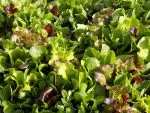This post contains affiliate links. If you buy something from one of our links we may earn a commission. Thanks
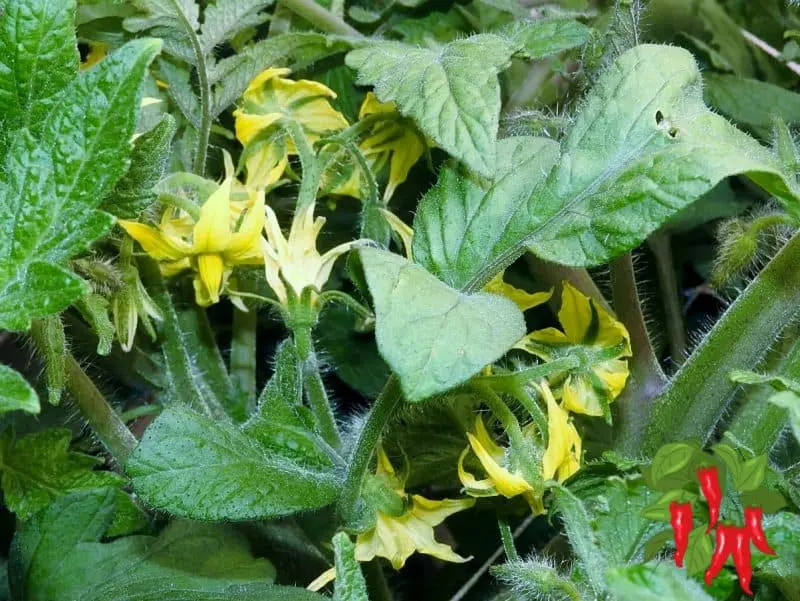
Hydroponic gardening at home is a great way to garden indoors. We will discuss the basics of hydroponic gardening and how you can get started with hydroponic gardening even for beginners and even if you don’t have a green thumb.
Hydroponic Gardening at home for beginners entails starting with a simple system like the Wick or the Kratky method, understanding the basic principles of hydroponics, and gradually moving on to more complex systems.
It requires gathering necessary supplies like a growing medium, nutrient solution, containers, and a lighting system if sunlight is insufficient.
The process involves placing plants in a nutrient-rich water solution, allowing them to grow faster and healthier compared to traditional soil gardening.
If you’re looking for a fun, unique way to garden, try hydroponic gardening. Hydroponics is a type of gardening that does not use soil. Instead, plants are grown in water and nutrient solutions.
Hydroponic Gardening At Home Has Many Benefits Including:
• Less maintenance required
• No weeds to pull
• Greater control over the growing environment
• Hydroponic gardens can be indoors or outdoors
• Use less water and fertilizer
• Higher yields and faster growth
What Is Hydroponics?
Hydroponics is a type of horticulture and a subset of hydroculture which involves growing plants, usually crops or medicinal plants, without soil, by using water-based mineral nutrient solutions in aqueous solvents. Terrestrial or aquatic plants may grow with their roots exposed to the nutritious liquid or in addition, the roots may be mechanically supported by an inert medium such as perlite, gravel, or othersubstrates. https://en.wikipedia.org/wiki/Hydroponics
This method is perfect for people who live in apartments with a small space or have limited space outdoors.
You can grow plants, flowers, leafy greens, and other vegetables all year round in your own home and save money at the grocery store.
We will discuss the basics of hydroponic gardening and provide tips on how to choose a hydroponic growing system.
The first step to starting a hydroponic garden is to understand the process. Hydroponics is different from traditional gardening.
Hydroponic gardening uses no soil but instead utilizes a nutrient solution and the roots of the plants are either suspended in water or an inert growing medium such as clay pebbles called hydroton or LECA.
The solution is typically composed of water, minerals, and other nutrients that are added to the water. Plants absorb the nutrients from this solution in order to grow and thrive.
Hydroponic Gardening At Home
Once you have a basic understanding of how hydroponics works, you will need to purchase some materials for your garden.
Growing Plants Without Sunshine
You will most likely need to use LED grow lights to provide your plants with light. In most of the U.S. the northern areas have very low light levels during the fall and winter.
So, if you want to grow hydroponic vegetables indoors year round you will need supplemental lighting. How To Grow Vegetables Indoors Without Sunlight
Hydroponic Equipment
Hydroponic gardens require specialized equipment such as grow lights, air pumps, irrigation systems, and containers for plants.
The first thing to do before you buy any hydroponic growing system or equipment is to do your research.
It’s important to research these items before making any purchases so that you can ensure you have all the necessary components for your own hydroponic garden.
There are many indoor gardening kits available online but before you buy one you need to have a good understanding of how that hydroponic system works.
Once you have the necessary materials, you will need to choose your plants. Hydroponic gardening allows for a wide variety of plants to be grown, from vegetables and fruits to flowers and herbs.
You should research different types of plants and figure out which ones are best suited for hydroponic gardening before making your selections.
Finally, it’s time to assemble your garden. Hydroponic gardens can be set up in almost any space; indoors or outdoors.
Make sure that you follow all the instructions on the equipment when setting up the system, as not doing so could lead to problems down the line.
Once everything is in place, you can begin adding nutrient solutions and monitoring temperature, EC or ppms of the nutrients, and pH levels.
Hydroponic gardening at home is an exciting and rewarding process. With the right equipment and some patience, home gardeners can create a beautiful garden in their own homes.
An Overview Of The Basic Hydroponic Systems
Before you get started growing anything we need to take a look at the most common hydroponic systems in use. Later we will make suggestions for which ones to build.
The Wick System
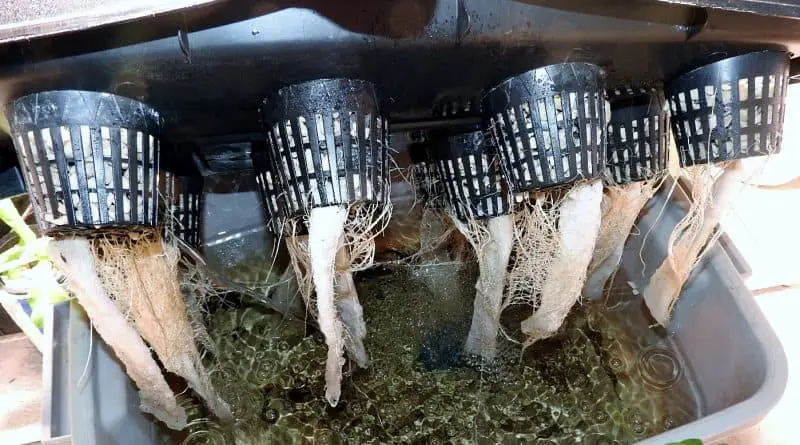
A hydroponic wick system is a type of hydroponic setup that relies on capillary action to deliver water and nutrients to the plant roots.
In a wick system, plants are grown in a growing medium, such as coconut coir or perlite, and placed in a container that is filled with water and nutrients.
The container is typically equipped with a wick, which is made of a material that absorbs water easily, such as cotton or polyester.
The wick is placed in nutrient-rich water, and the other end of the wick is placed in contact with the growing medium.
As the plant grows, it absorbs water and nutrients from the growing medium. This causes the water level in the reservoir to drop, creating a concentration gradient between the water in the container and the water in the growing medium.
The capillary action of the wick then causes the water to be drawn up from the container and into the growing medium, where it is taken up by the plant roots.
This process continues as long as there is water and nutrients available in the container, providing a steady supply of moisture and nutrients to the plants.
One advantage of a wick system is that it is simple to set up and maintain. Because it relies on capillary action, rather than a mechanical pump, a wick system is typically very low-maintenance but it can’t be easily automated.
Additionally, because the plants are grown in a growing medium, rather than suspended in water, they are less vulnerable to problems like root rot, which can be a common issue in other hydroponic systems.
This is a good system for growing fresh produce or fresh herbs and it is an easy indoor hydroponic garden to set up.
If you are a beginner this is how to build a cheap hydroponic system and because it is an easy hydroponics at home DIY project. It can be as simple as placing pots on a wet mat or hanging their wicks into a container.
However, it works best for smaller plants. Large plants like tomatoes will have a larger root system and may not receive enough water with this system.
Drip Systems
Drip irrigation is a type of hydroponic system that uses a network of feeder tubes and emitters to deliver water and nutrients directly to the roots of plants.
In a drip irrigation system, plants are grown in a growing medium, such as, hydroton, coconut coir or perlite, and placed in containers that are equipped with a drip irrigation setup.
The drip irrigation setup consists of a series of tubes, valves or manifolds, and emitters that are connected to a water and nutrient solution source.
The water and nutrient solution is pumped from the source and flows through the tubes, where it is metered out by the emitters.
The emitters are typically small nozzles or drip holes that release a precise amount of water and nutrients onto the grow medium, directly around the plant roots.
The plants absorb the water and nutrients from the grow medium, and the excess solution is drained back into the reservoir for recirculation.
Drip irrigation systems are popular because they are efficient and precise. The drip emitters allow for precise control over the amount of water and nutrients that are delivered to the plants, which can help to optimize plant growth and prevent over-watering or nutrient deficiencies.
Additionally, because the water and nutrients are delivered directly to the plant roots, the system is relatively low-maintenance and can be easily automated.
Here is how to build a closet drip system
Describe The Kratky System
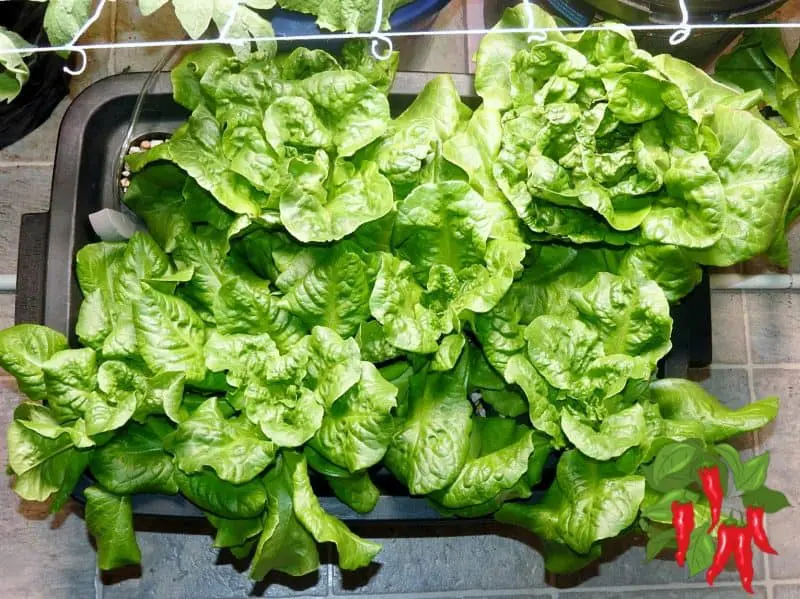
The Kratky system is a popular method of hydroponic gardening that utilizes non-circulating Hydroponics. This method requires no pumps or other moving parts and is relatively easy to set up.
The Kratky Lettuce Raft is popular with commercial lettuce growers. Plants are inserted in a styrofoam raft which floats inside a container of water and nutrients.
In the Kratky system, plants are placed in containers filled with a nutrient solution and there are no air stones to provide oxygenation to the roots.
If you add airstones your Kratky becomes a DWC and I do think adding airstones is a good idea.
Your plants will grow faster and if you use airstones you can control the water level and nutrient solution better.
As the plant grows, the water level slowly drops due to evaporation and absorption by the plant’s roots.
The pure Kratky system does not add more water so it is limited to fast-growing plants like lettuce or other greens. As plants grow the water level drops and exposed roots become air roots.
Ideally, the plants are done when the water is used up. But this doesn’t always work out that way.
If you refill the reservoir they can be damaged by a higher water level. But as I recommend if you add an airstone you can top up the reservoir as needed.
The Kratky system is ideal for beginners as it can be easily maintained with minimal equipment and provides successful results in most cases.
Here is a Kratky method lettuce grow.
Describe The DWC Method
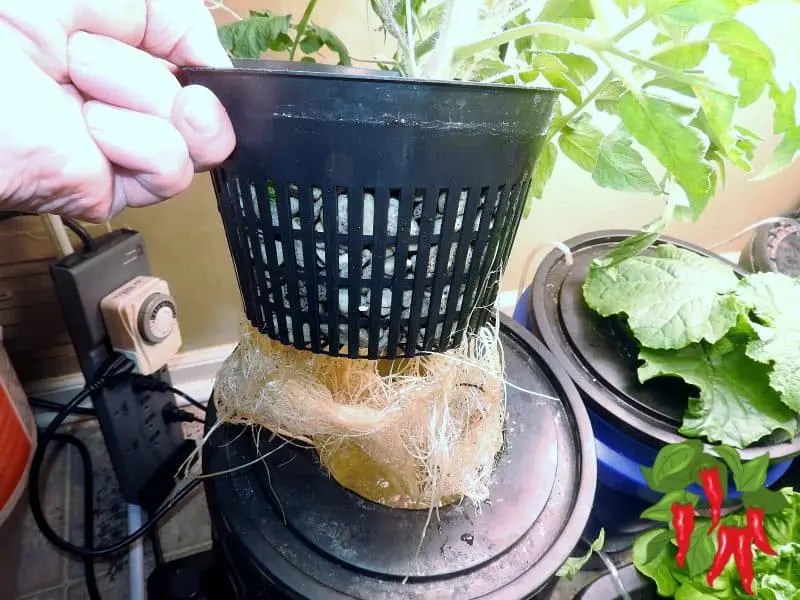
The DWC (Deep Water Culture) Hydroponics method is a type of hydroponic gardening that utilizes the process of submersion.
Plants are placed in net pots filled with inert media and the roots are suspended in a container with a nutrient solution in it.
An air pump provides oxygenation to the roots. The plant can be grown in a single 5-gallon bucket or the nutrient solution may be recirculated throughout the system in RDWC, allowing for greater control over pH levels and other environmental factors that may affect growth.
A variation on a single bubble bucket is RDWC or recirculating deep water culture where multiple buckets are hooked together in larger systems and a water pump in a central reservoir recirculates the water to the buckets.
The plants are kept submerged at all times and provided with a constant supply of nutrients which allows them to remain healthy and produce larger yields than traditional soil-based gardens.
Monitoring your ph level and water temperature is critical for the best results. The deep water culture system requires more maintenance than other Hydroponic systems but can be very rewarding if done properly.
Learn more about DWC bubble buckets
Describe The Ebb And Flow System
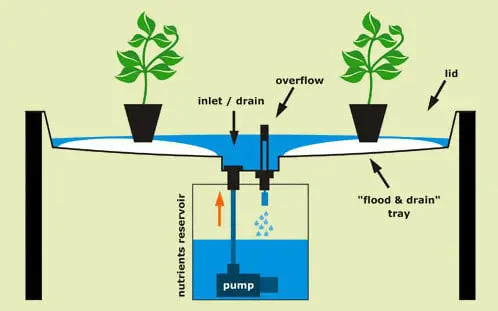
The Ebb and Flow Hydroponics system is a popular method of Hydroponic gardening that utilizes the process of flooding and draining.
It is also called a flood and drain system.
Plants are placed in containers filled with grow stones or hydroton. Sometimes this is mixed with coco coir.
The nutrient solution in a reservoir below the flood tray is pumped into the tray. Usually, an air pump provides oxygenation to the nutrients.
A timer-controlled water pump opens and closes at regular intervals, allowing for nutrient solutions to be periodically flooded onto the plants’ roots.
After the flood cycle, the water drains back to the reservoir where it can be recirculated again.
This system allows for greater control over pH levels and other environmental factors that may affect growth.
It also requires less maintenance than DWC Hydroponics systems but can provide successful results.
The main disadvantage to flood and drain systems is they need a lot of space as compared to some other systems because they use a large growing tray and water reservoir.
This is one of the best and easiest to use hydroponic systems and even though I am an experienced hydro grower I use this type of system.
But I use it with a top feed drip system instead of flooding. I recommend using an ebb-and-flow system if you have enough room.
My flood and drain system was altered to use top-feed drip irrigation and is fully automated. All I need to do is monitor my nutrient reservoir.
Describe The NFT System
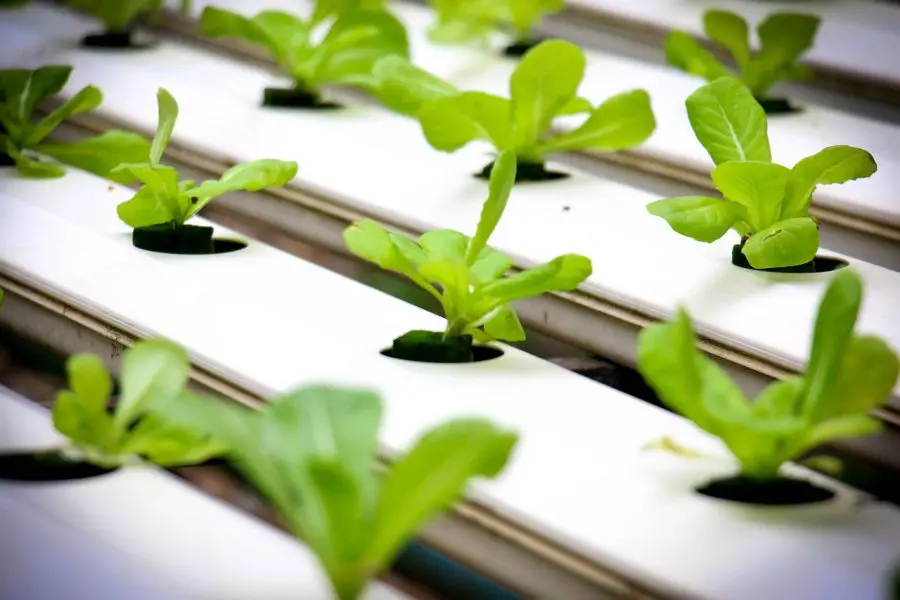
The Nutrient Film Technique (NFT) Hydroponics system is a type of hydroponic gardening that utilizes a thin film of nutrient solution running through a channel or pipe.
Plants are placed in containers filled with an inert growing media which are then inserted into holes in the channel.
The nutrient solution is continuously pumped into the channel, providing a thin film of water over the bottom and the plant’s roots grow down into it.
This system is very popular with commercial growers who use it for leafy greens. It is not really suitable for growing large plants but it works really well for smaller fast-growing plants.
This system allows for greater control over pH levels and other environmental factors that may affect growth and requires minimal maintenance compared to other Hydroponics systems. It also produces higher yields with less effort than traditional soil-based gardens.
It can be more difficult for a home grower to build from scratch but smaller-sized NFT kits are available and easy to set up and use.
Describe The Aeroponic System
The Aeroponic Hydroponics system is a type of hydroponic gardening that utilizes the process of misting nutrient solutions onto plant roots.
Plants are placed in containers filled with air rather than liquid solutions and an a pump sprays the roots with small missing nozzles and this provides oxygenation to the roots.
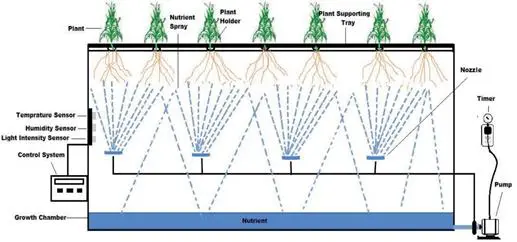
The nutrient solution is sprayed onto the plant’s roots in a fine mist, providing them with all of the necessary nutrients and allowing for greater control over pH levels and other environmental factors that may affect growth.
This system requires more maintenance than other hydroponics systems and it is prone to failure if problems arise.
Although it can produce really fast growth I really can’t recommend it because it is difficult and time-consuming to manage.
FAQs on Hydroponic Gardening:
Embarking on the journey of hydroponic gardening can spark a multitude of questions, especially when you are just getting started.
It’s a unique realm of gardening that, while extremely rewarding, comes with its own set of considerations and learning curves.
Below are some frequently asked questions that encompass the basic inquiries budding hydroponic gardeners often have.
These Q&As are aimed to provide a clearer understanding and a smoother initiation into the fascinating world of soilless gardening.
Q. What are the basic requirements for starting a hydroponic garden at home?
A. The basic requirements include a growing system (like Wick, Kratky, or DWC), a nutrient solution, a growing medium (like coconut coir or perlite), containers for plants, and a lighting system if natural sunlight is not sufficient. Additionally, you’ll need seeds or seedlings of the plants you wish to grow.
Q. How do I choose the right hydroponic system for my home?
A. The choice of a hydroponic system depends on your space, budget, and the plants you want to grow.
Beginners might find Wick or Kratky systems easier to start with. As you gain experience, you can explore more complex systems like NFT or Aeroponic.
Q. Is hydroponic gardening expensive to start?
A. The initial setup cost can be higher compared to traditional soil gardening.
However, hydroponic gardening often results in higher yields, faster growth, and lower maintenance costs over time.
Starting with a smaller, simpler system can help mitigate costs.
Q. Can I grow any type of plant hydroponically?
A. Most plants can be grown hydroponically, but leafy greens and herbs are often the easiest for beginners. Larger fruiting plants like tomatoes and peppers can also be grown but may require more advanced systems and additional care to thrive hydroponically.
Final Thoughts
Hydroponic gardening at home has become increasingly popular over recent years as it offers many benefits for both the environment and your wallet.
With careful planning, Hydroponics systems can be tailored to fit any budget or space and will produce healthy, plentiful yields with minimal effort.
Hydroponic gardening is an exciting way to get creative with gardening and enjoy the fruits (or vegetables.) of your labor.



